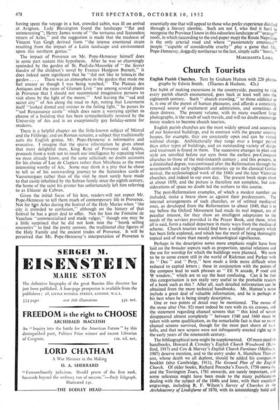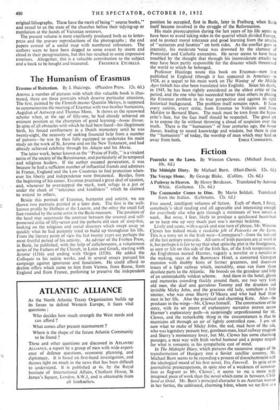Church Tourists THE habit of making excursions in the countryside,
pausing to visit every parish church encountered, goes back at least well into the eighteenth century. Such " church crawling," to those addicted to it, is one of the purest of human pleasures, and affords a constantly renewed source of excitement and admiration, and sometimes of deep distress. The present volume, with its many excellent large photographs, is the result of such travels, and will no doubt encourage many readers to become church tourists.
English parish churches are the most widely spread and accessible of our historical buildings, and in contrast with the greater country houses, for example, they are constantly open and can be visited without charge. Architecturally they range over a longer period than other types of buildings, and an outstanding variety of design and treatment is found in them. The successive changes in plan and style are unrolled before our eyes from the earliest pre-Conquest churches to those of the mid-sixteenth century ; and this process, in a diminished degree, was continued after the Reformation through the seventeenth and early eighteenth centuries up to the classical Gothic revival, the ecclesiological work of the 1840s and the later Victorian churches, and indeed to our own day. The present book stops short at about 1850, and the picture is therefore not complete, but con- siderations of space no doubt led the authors to this course.
The post-Reformation examples, of which a modest number are included, make a brave show as against their predecessors. The internal arrangements of such churches, or of refitted mediaeval ones, as developed from the Reformation to about 1840, that is to say before the Oxford Movement had made its real impact, are of peculiar interest, for they show an intelligent adaptation to the needs of the services provided in the Prayer Book, and these, when all is said, form a radical departure in many ways from the mediaeval scheme. Church tourists would find here a subject of enquiry which has been little explored, and which has the merit of being thoroughly topical and of more than merely archaeological significance.
Perhaps in the descriptive notes more emphasis might have been laid on the broader aspects such as proportion, spatial relations and the use for worship for which the buildings were planned. We seem to be to some extent still in the world of Rickman and Parker with its " Dec " and " Perp," here made a little more difficult when reduced to capital letters ; these in conjunction with the points of the compass lead to such phrases as " EE N arcade, P roof and W window," which are to say the least confusing. Can it be that this categorisation is not really very useful to the probable readers of a book such as this ? After all, such detailed information can be obtained from the more technical handbooks. Mr. Hutton's notes include a great deal of valuable information, and he is perhaps at his best when he is being simply descriptive.
One or two points of detail may be mentioned. The mensa of the stone altar (No. 92) must indeed be rare with its six crosses, and the statement regarding chancel screens that " this kind of screen disappeared almost completely " between 1540 and 1660 must be taken with some qualification, as the remarkable fact is that so many chancel screens survived, though for the most part shorn of mar lofts, and that new screens were not infrequently erected right up to the early years of the nineteenth century.
The bibliographical note might be supplemented. Of more modern handbooks, Howard & Crossley's English Church Woodwork (13a,- ford, 1917) and Cox & Harvey's English Church Furniture (Methum, 1907) deserve mention, and to the entry under A. Hamilton Thomp- son, whose death we all deplore, should be added his compan.on booklet (also Cambridge, 1911), The Ground Plan of the English Church. Of older books, Richard Pococke's Travels, 1750 onwards, and the Torrington Tours, 1781 onwards, are surely important, and some reference might have been made to the many publications dealing with the subject of the 1840s and later, with their excellent engravings, including R. F. Wilson's Survey of Churches in the Archdeaconry of Lindisfarne of 1870, with its astonishingly bold and original lithographs. These have the merit of being " source books," and reveal to us the state of the churches before their tidying-up or mutilation at the hands of Victorian restorers.
The present volume is most excellently produced both as to letter- press and the gravure reproductions of the photographs ; the end papers consist of a useful map with numbered references. The authors seem to have been dogged to some extent by storm and cloud in their peregrinations, but this has resulted in some impressive exteriors. Altogether, this is a valuable contribution to the subject and a book to be bought and treasured. FREDERICK ETCHELLS.



































 Previous page
Previous page